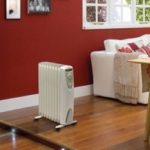Comparison of convector and electric boiler
The heating system of a private house is always a difficult task. Often, the consumer is faced with the task of choosing which is better to use: electric boiler or convectors? In this situation, it is necessary to analyze all the advantages and disadvantages, calculate the economic benefit, efficiency, calculate the possible nuances. There is no universal solution, the right choice is the most adapted option, which will take into account a number of nuances:
- regular home visits;
- the area that needs to be heated;
- duration of use of the premises;
- financial opportunities.

Content
Description of electric convectors
Convector heaters are a modern development that combines thoughtful design, simple operation and installation, universal or exclusive design.
The operation of the convector is simple: in the lower part of the rectangular case of the device there are structural holes through which cold air enters the device. Under the influence of the heating element, the air masses are heated and, according to the law of physics, rise, freeing up space for the cold. Thus there is a natural movement, or convection, of air masses.
Electric convectors (there are also water and gas) Fully ready to use and quite easy to manage. To start the device, it is enough to install and connect it to the mains. The advantages of these heaters include:
- simple installation;
- easy use;
- functionality;
- reliability;
- environmental friendliness and safety for a human body.
Environmentally friendly due to the relatively low temperatures of the heating elements.Unlike classical radiators, heating convectors do not burn oxygen or dust, do not dry the air (more about the action scheme -how does electric convector work).
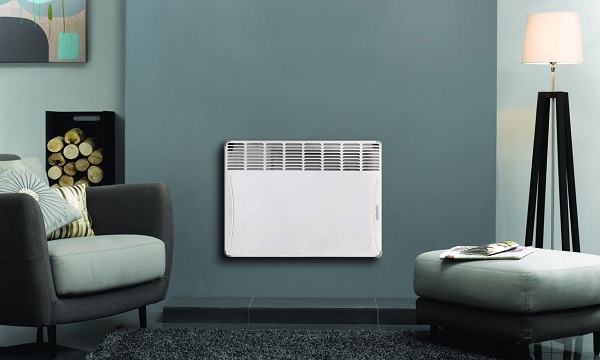
Electroconvector installation
Heating convector heaters are easy to install. The case of the device reaches low temperatures, which allows you to mount the device in any place, without fear of spoiling the decorative finish, the interior. Electric convectors are divided into types according to the installation method:
- universal;
- wall mounted;
- floor standing;
- embedded.
Universal Convector heaters are attached to the wall on the brackets or installed on the floor. The package includes legs or rollers. Universal installation method allows you to change the location of the heater. Fastening of the convector can be done by hand.
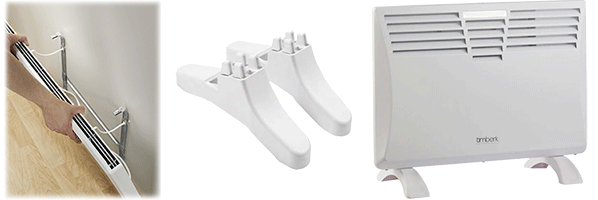
Wall mounted the models are installed in the same way as the universal, with the exception of a complete set that does not provide for additional legs for installation on the floor. But if the design allows, they may well be purchased separately. The device can be mounted near the decorative elements or on a delicate decorative finish, but it should be borne in mind that the warm air moves vertically from the device.It is not recommended to place flowers, houses of pets or any objects that may overheat or block the flow of warm air masses above it.
Built-ine models of convector heaters are installed in a special niche in the floor at least 20 cm deep. The top of the heater is covered with a grill. This type refers to the stationary, the device can not be moved. As a rule, built-in heaters are used for non-residential premises - exhibition halls or shopping centers, where the convector creates a heat curtain. In private homes, such devices are used in cases where the walls are completely made of glass. There are also models that can be embedded in the window sill.
Heating by convectors
Often for heating houses use convector heaters. Such devices, in most cases, do not require installation. Devices are installed in rooms, corridors, loggias, connecting to the mains.
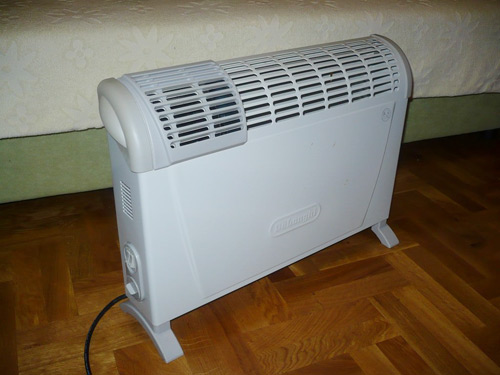
Convector Heater
The lack of special handling during installation is compensated for relatively high energy consumption, as well as a complete dependence on it.By the way, there is some benefit here. In case of malfunctions with the network, a single gasoline (diesel) generator of average power is enough to put at least one convector into operation. This will already be enough to keep the building warm, not to freeze the pipeline.
When the house needs additional heating, the convector will be a competent and rational decision. Heaters are compact, easy to install or move (for some types). The functionality of most devices allows you to adjust the power and intensity of heating.
Note! It is not recommended to save on the number of devices. Insufficient heating of concrete structures leads to the formation of excessive moisture and mold. Naturally, it all depends on the climate, but this problem is quite common for owners of this type of device.
The appearance of the heating devices rarely taken into account, but in the case of this type of heaters, this moment can not be ignored. In the assortment of stores you can find a variety of universal models, stylish convectors of the average price category.But you can create an individual order when the manufacturer will put an image on the panel, or revet it with a natural stone. The last option is the most expensive, but it is suitable for those who subtly calculates and plans the design of the premises.
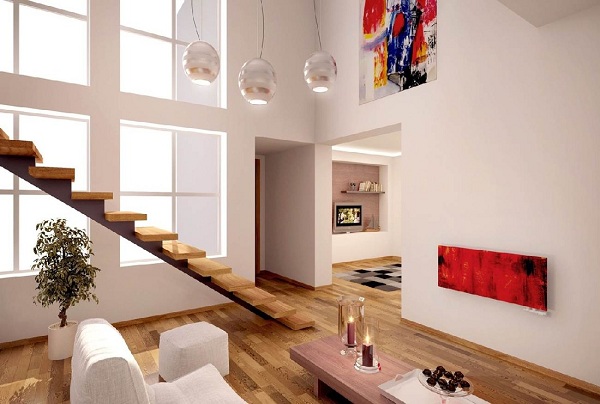
Pros and cons of convectors
So, what are the advantages of heaters of this type:
- no installation costs;
- possibility of installation only in the necessary rooms (as well as the disconnection of appliances in enclosed or unused premises)
- mobility (plus take up little space);
- ease of use, accessible to everyone;
- convective heaters can be placed in any premises, including bathrooms or switchboards;
- large selection of options and additional functions;
- safety, environmental friendliness;
- external aesthetics.
Among the disadvantages are the following:
- inefficiency;
- cost (in some cases).

What is an electric boiler
An electric boiler is a heating device, the principle of its operation is to convert electrical energy into heat. The heating element acts on the flow-through fluid circulating through the pipes of the heating system.Simply put, teny come into contact with water (or other chemical liquid), which moves through the pipeline, heating it. Radiators, in turn, warm the air.
Electric boilers are distinguished by several features. By installation type devices are divided into:
- wall mounted;
- floor standing
By types of heating elements:
- ten;
- electrode;
- induction.
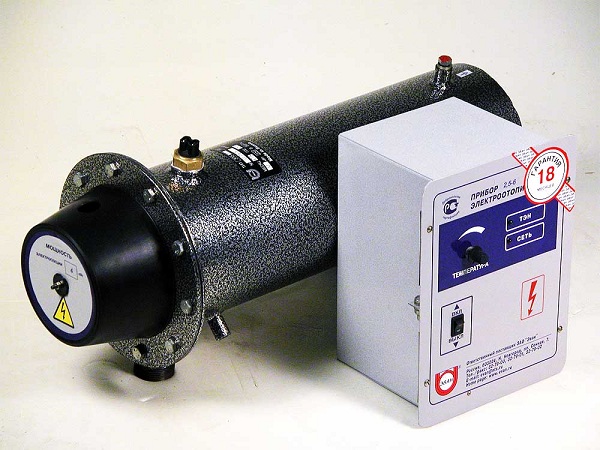
Induction Electric Boiler
Also models differ by power (power consumption) and functionality. The most accessible and simple boilers contain a heater and starting equipment, medium-functional equipment is equipped with temperature control and monitoring units, and the most “top-end” ones are controlled remotely.
Note! Models with tenami can have a dual-circuit system that will provide the house not only with heat, but also with hot water.
Coolant is distilled or salt water, and antifreeze can be poured into induction boilers. In both cases, the cost of the liquid is quite low.
Description of heating elements of electric boilers
It is worth considering in more detail the types of heaters used in electric boilers. Some values can significantly affect the choice of a suitable model.
Tubular tena used in various devices: dishwashers and washing machines, convectors, as well as in electric heating boilers. The elements are completely immersed in the coolant and transfer heat to them. Of the advantages can be noted the low cost and simple replacement of tenov, out of order.
There are also some disadvantages of such heaters, for example, if the element is not fully immersed in the coolant, then it quickly burns out. Scale forms on the shade, which slows down heat transfer somewhat.
Induction The type differs in quite considerable cost (both the equipment itself and its components), but this is offset by the increased efficiency of the device. Heating is carried out due to the influence of a magnetic field (similar to induction electric stoves) on the coolant.
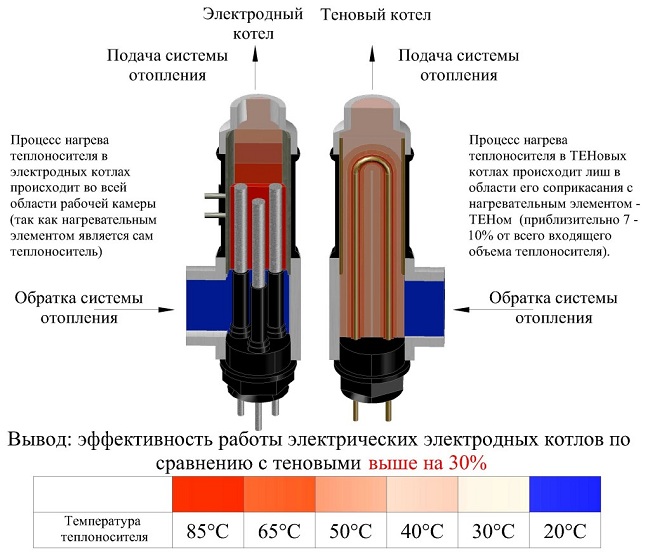
The design is very durable, the internal mechanisms do not wear out, except for the control unit. If the plans are long-term use of the heating device, for example, permanent residence in a country house, then this type of system will be optimal.
Electrode boilers whimsical to the composition of the coolant, the water should not be distilled, and with a salt content. Moreover, the rate of content is calculated after measuring the current.Here you will have to carefully study the instructions and determine the optimal composition of the water.
Boiler installation
In comparison with the convector, the electric boiler is much harder to mount. If the convector heaters are fully ready for use after the purchase, then the boiler will need assembly and installation of the pipeline. Moreover, you should first analyze and plan where it will be held, in which premises it should be taken. Of course, this will require additional costs and time, because for heating with electric boilers, the preparation must be started in advance.
Despite the difficulties of installation, it cannot be said that it is better to use a conventional convector (or similar heaters) instead of electric boiler. The piping system heats the air with its entire surface, and the convectors provide local heating. Speaking of the pipeline itself, you can use as radiators aluminum elements.
By itself, the boiler does not take up much space, looks aesthetically pleasing, but is devoid of decorative properties. As a rule, it is mounted in a separate or utility room.Because in the kitchen or in the room it will not always look appropriate.

Installation of an electric boiler
Economic performance and comparison of heating devices
What is more economical: a boiler or an electric convector? It is worth noting that both the first and second options - energy consuming. But actual costs are affected by the floor space, the size of the heat loss, and the characteristics of a particular device. The average calculations for both devices are approximately equal: an area of 20 m² will require 2 kW of power, and a house of 100 m² will require at least 10 kW, which will be approximately 240 kW per day.
Analyzing characteristics of electric boilers, we can conclude that this type of heating system is similar to the usual, as in high-rise buildings, and is stationary. Costs and time for laying the pipeline will be required only once, after which, the adjusted system will not require special manipulations. But such a system is not mobile, the convector can be moved or turned off, unlike the electric boiler. The pipeline, theoretically, can be optimized and install additional valves for closing the circulation of the coolant. In practice, this is quite difficult to implement.The boiler is also not rational for small rooms.
This type of heaters requires stable and reliable mains voltage, if problems occur, the heating will stop throughout the house. The generator can be an output only if the power consumption of the device is on average 3-4 kW.
Convector systems heating is devoid of problems with the organization of work, and practically have no flaws. The user can choose both budget and decorative model. The downside is that they do not have a single control center, more precisely, it must be purchased and configured separately. Crawling around the rooms, setting up and adjusting several units, checking and maintaining them in working condition will all take at least daily time.
In practice, users typically use convector heaters as a temporary and simple solution, until a permanent heating network is laid. Later, the devices serve as additional or emergency heating.

/rating_off.png)






